Business Intelligence (BI) has transformed significantly over the past decade, evolving from traditional data reporting tools to sophisticated platforms that leverage artificial intelligence and machine learning to deliver predictive and prescriptive analytics. Modern BI tools are not just about generating reports; they enable organizations to uncover hidden patterns, identify trends, and gain actionable insights. While traditional ETL (Extract, Transform, Load) technology moves data from operational systems to data warehouses, reverse ETL pushes insights back to operational systems like Customer Data Platforms (CDPs). This enables real-time data synchronization, empowering marketing teams with up-to-date information. By feeding BI insights directly into CDPs, organizations enhance customer experiences. The integration of AI and ML into BI platforms allows for more accurate forecasting and the automation of data analysis processes. Additionally, the shift towards self-service BI empowers non-technical users to create and customize their own dashboards, democratizing data access across organizations.
Latest Trends in Business Intelligence: AI and Beyond
Business Intelligence (BI) continues to evolve, driven by the need for data-driven decision-making and advancements in AI and ML technologies. According to MarketsandMarkets, the Business Intelligence market was expected to grow from USD 23.1 billion in 2020 to USD 33.3 billion by 2025, at a CAGR of 7.6%, driven by digital transformation, analytics investments, data visualization demand, cloud adoption, and increasing data generation. The shift toward self-service BI has empowered non-technical users to access and analyze data without relying on IT teams. This democratization of data has been crucial in enabling businesses to be more agile and responsive to market changes.
One significant trend in BI is the increasing use of AI and ML for predictive and prescriptive analytics. These technologies enable businesses to forecast future trends and make proactive decisions. Additionally, the rise of augmented analytics, which combines AI, ML, and NLP, is making it easier for users to gain insights from their data without extensive technical knowledge. For example, augmented analytics can automatically highlight significant patterns and anomalies in data, making it easier for users to focus on critical issues.
Another emerging trend is the integration of BI with other business systems. Reverse ETL is gaining traction, allowing insights from BI tools to be pushed back into operational systems, such as CRM and ERP systems. This real-time data synchronization ensures that decision-makers always have access to the latest information, improving overall business agility.
Impact of Cloud Computing on Business Intelligence
Cloud computing has revolutionized the Business Intelligence field by providing scalable, flexible, and cost-effective solutions. Cloud-based BI platforms facilitate seamless integration with various data sources, enabling organizations to consolidate data from disparate systems into a unified view. This holistic approach to data management enhances data quality and accuracy, providing a more reliable foundation for analytics.
Cloud BI tools offer numerous advantages, including reduced infrastructure costs, scalability, and the ability to access data from anywhere. These tools often come with built-in security features and compliance certifications, addressing concerns related to data privacy and protection. Furthermore, cloud BI solutions support collaborative analytics, allowing teams to work together on data analysis and share insights in real-time.
The future of cloud BI looks promising, with the increasing adoption of hybrid and multi-cloud strategies. These approaches offer businesses the flexibility to optimize their BI workloads across different cloud environments, balancing performance, cost, and compliance requirements. As cloud technologies continue to advance, we can expect further enhancements in BI capabilities, such as real-time analytics and more sophisticated data integration options.
AI & Data Governance in BI
Artificial Intelligence is transforming Business Intelligence by enabling advanced data analysis techniques and automating complex analytical tasks. For example, AI-driven BI tools can analyze customer data to predict purchasing behavior, enabling businesses to tailor their marketing strategies effectively. AI enhances data analysis through machine learning algorithms, which can identify anomalies, correlations, and patterns in data. NLP allows users to interact with BI tools using natural language queries, making data analysis more accessible. Additionally, AI-powered BI platforms can automate routine tasks, such as data cleaning and report generation, freeing up analysts to focus on more strategic activities.
Separately, in the context of BI, data governance ensures that the data used for analysis is accurate, consistent, and compliant with relevant regulations. This is increasingly important due to data privacy regulations such as GDPR and CCPA. BI tools must provide features like data lineage tracking, role-based access control, and audit trails to help organizations meet these regulatory requirements.
Top 15 Business Intelligence Software of 2024
As we explore the top 15 BI software solutions, it’s essential to consider how each platform can be tailored to meet your organization’s specific needs and challenges, ensuring that you remain at the forefront of innovation and efficiency. The following BI solutions come with unique features and advantages:
1. Microsoft Power BI Embedded
Microsoft Power BI Embedded allows developers to seamlessly integrate visual analytics into their applications without the need for building these features from scratch. This service simplifies the incorporation of Power BI’s capabilities, such as stunning visuals, reports, and dashboards, facilitating quick data exploration and decision-making for users. With its drag-and-drop interface and extensive API integrations, Power BI Embedded provides a robust solution for embedding analytics into various applications.
Key Features Highlighted by Reviewers
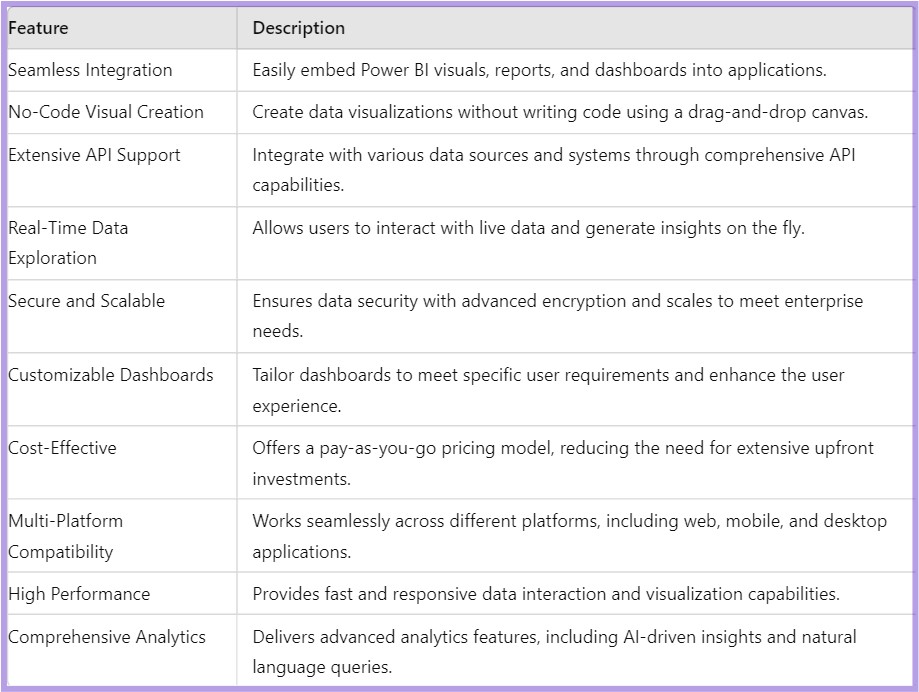
2. Looker Studio
Looker Studio provides flexible self-service business intelligence, enabling users to create and share visually rich, intuitive reports and dashboards. With connections to over 1,000 data sources, it empowers users to generate impactful data visualizations and collaborate effortlessly. Enhanced by Duet AI, Looker Studio automates report generation, saving time and driving smarter business decisions.
Key Features Highlighted by Reviewers
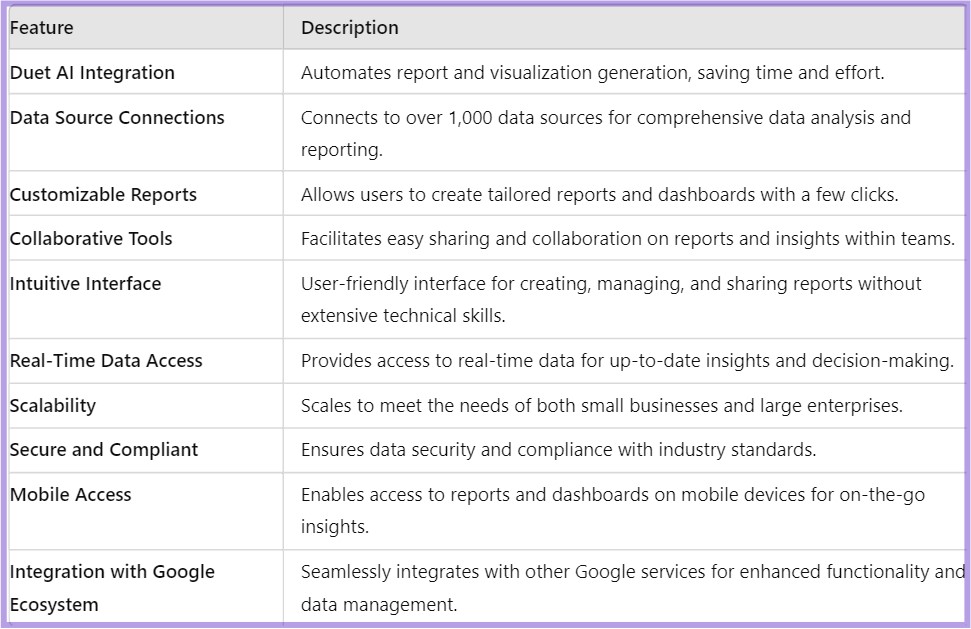
3. SAP BusinessObjects BI
SAP BusinessObjects Business Intelligence is a scalable and flexible platform designed to help businesses easily discover and share insights for better decision-making. It offers comprehensive data reporting, visualization, and sharing capabilities, available both on-premise and in the cloud. The platform integrates seamlessly with various data sources and provides robust tools for ad hoc queries, interactive dashboards, and advanced analytics.
Key Features Highlighted by Reviewers
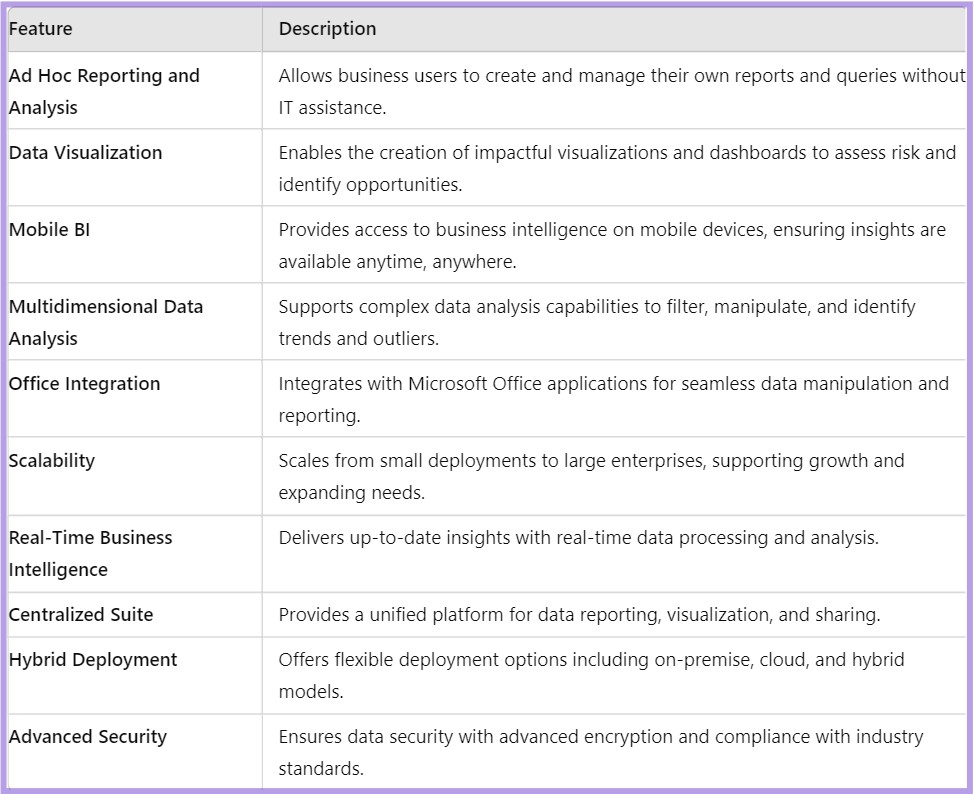
4. Tableau
Tableau is an advanced analytics platform designed to transform the way organizations use data to solve problems, making data accessible and actionable. It integrates deeply with Salesforce’s Einstein AI, providing powerful data management, visual analytics, and data storytelling capabilities. Tableau empowers users of all levels to explore and analyze data through features like Tableau Prep for data preparation and Tableau Pulse for personalized, contextual insights.
Key Features Highlighted by Reviewers
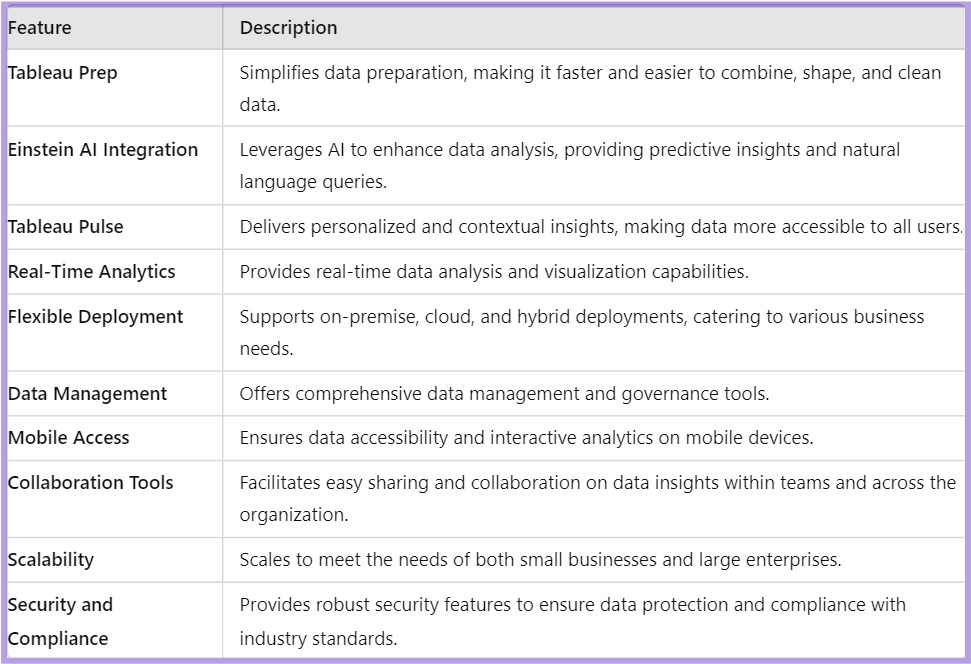
5. Qlik
Qlik Sense empowers users to make data-driven decisions by offering augmented analytics for various business needs, including visualization, dashboards, and natural language analytics. Its unique associative technology enhances human intuition with AI-powered insights, enabling the discovery of hidden insights that traditional query-based tools might miss. The platform also supports custom and embedded analytics, reporting, and alerting, making it a comprehensive solution for modern business intelligence.
Key Features Highlighted by Reviewers
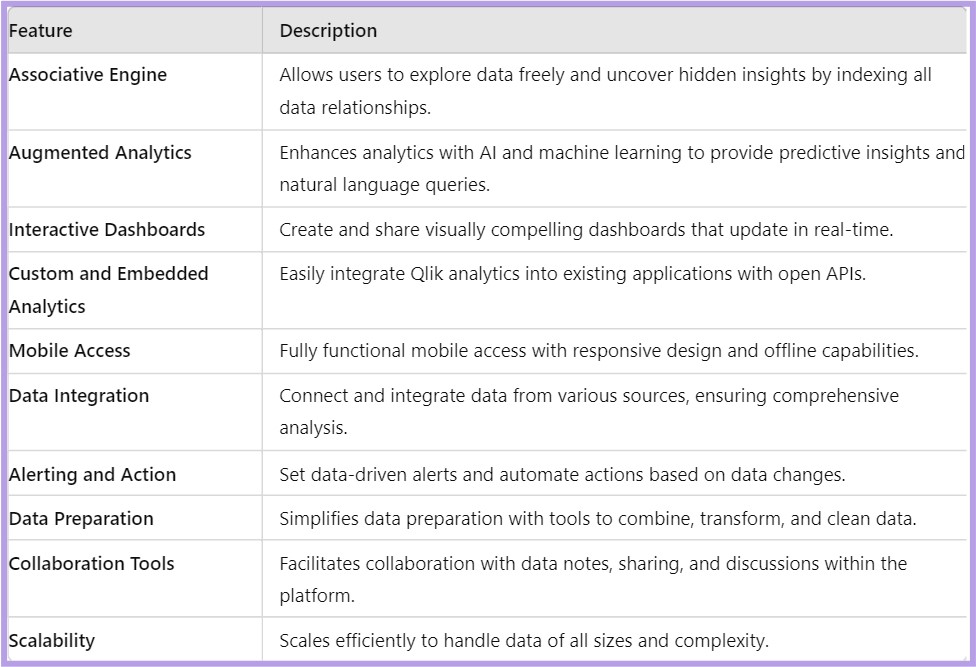
6. Datamatics TruBI
Datamatics is an enterprise-ready business intelligence platform that features a modern and responsive user interface. It supports self-service analysis and offers a 360-degree view of a single version of the truth, providing an intuitive and interactive experience in a secure and scalable environment. TruBI’s advanced data visualization capabilities and robust performance make it ideal for organizations looking to enhance their decision-making processes.
Key Features Highlighted by Reviewers
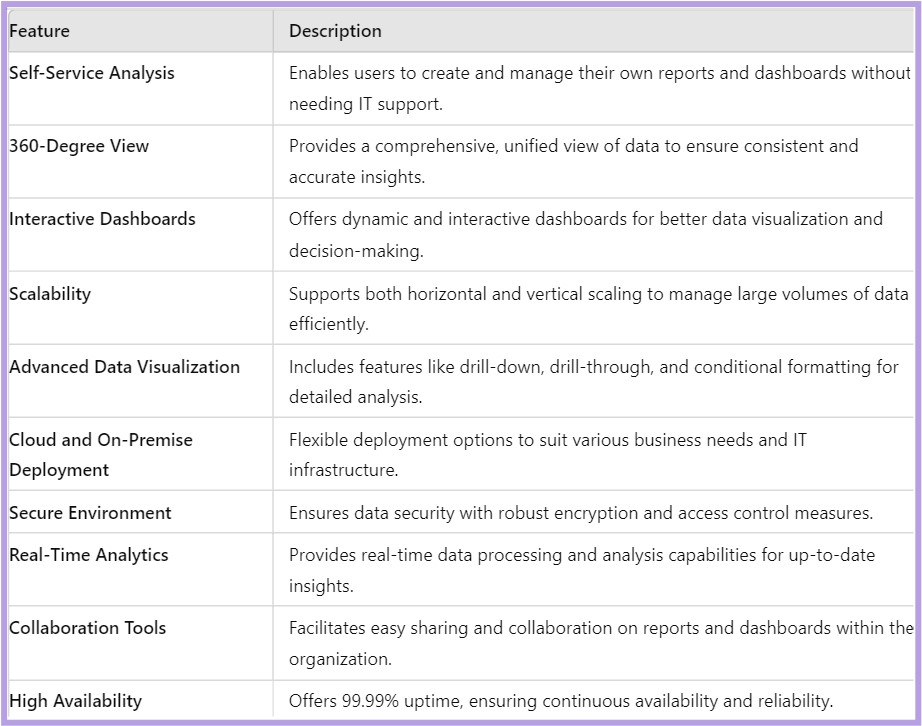
7. MicroStrategy
MicroStrategy is a leading AI-powered business intelligence platform that provides comprehensive analytics solutions for enterprises. Renowned for its scalable and high-performance capabilities, MicroStrategy supports everything from pixel-perfect reporting to advanced data visualizations and mobile analytics. With a modern cloud-native architecture, it seamlessly integrates AI into all data workflows, enhancing decision-making processes for some of the world’s most recognized brands.
Key Features Highlighted by Reviewers
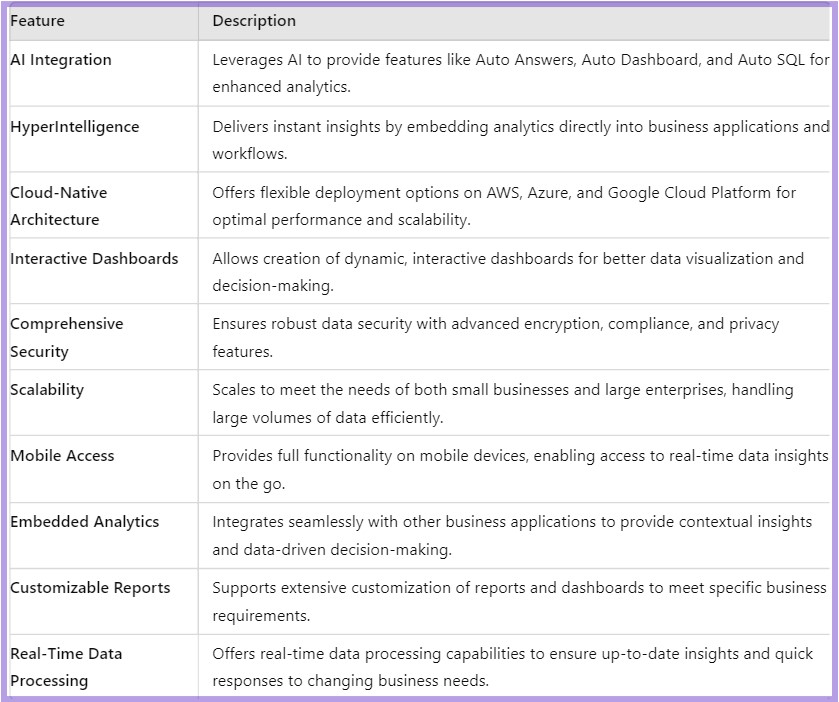
8. SAS Business Intelligence
SAS Business Intelligence provides a robust and flexible presentation layer for a wide range of SAS Analytics capabilities. It integrates comprehensive business analytics software and services, empowering organizations to transform data into actionable intelligence. SAS BI supports self-service data preparation, interactive data visualization, and advanced analytics, enabling users to make data-driven decisions efficiently.
Key Features Highlighted by Reviewers
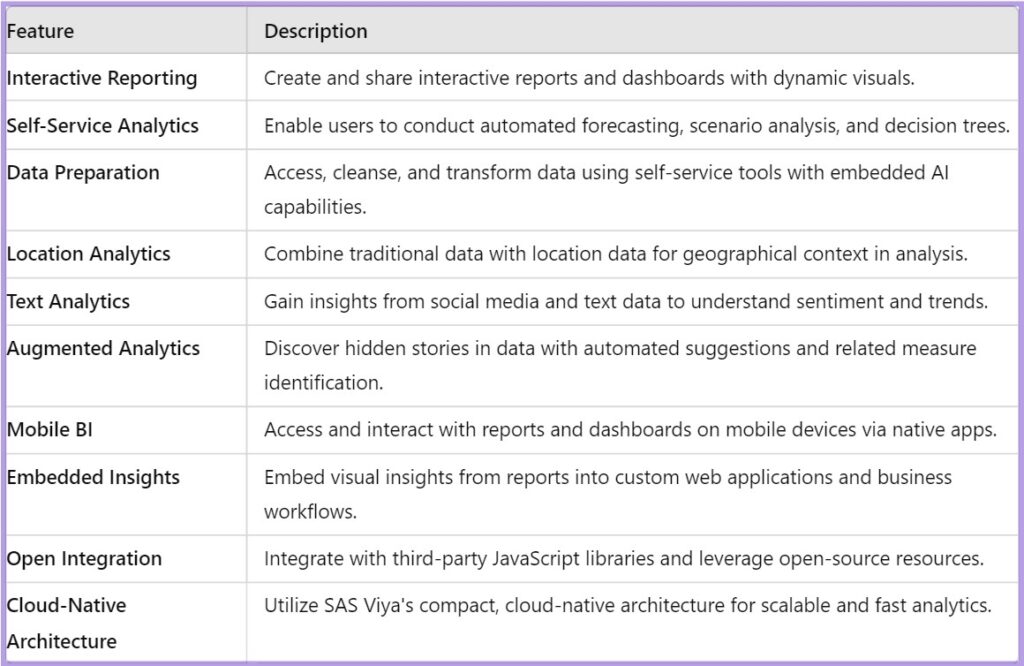
9. Sisense
Sisense goes beyond traditional business intelligence by infusing analytics into customer and employee applications and workflows. Its AI-driven analytics cloud platform, Sisense Fusion, provides highly customizable analytics that integrate seamlessly into business processes, enabling timely and informed decision-making. More than 2,000 global companies rely on Sisense to innovate, disrupt markets, and drive meaningful change, making it a leading choice for modern BI needs.
Key Features Highlighted by Reviewers
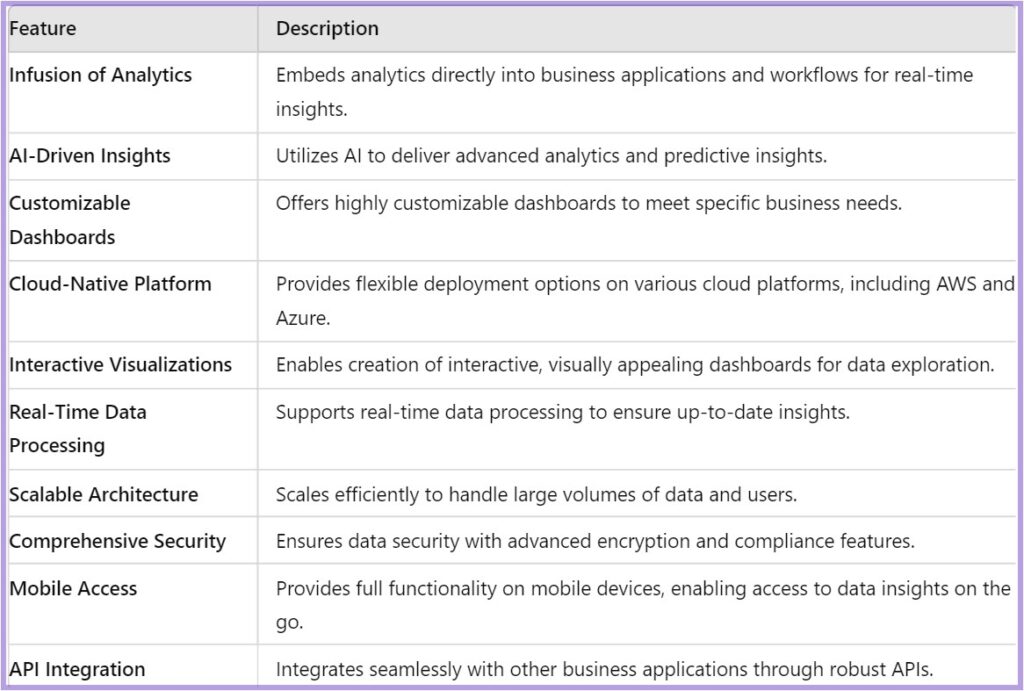
10. Yellowfin BI
Yellowfin BI is a comprehensive analytics suite that combines action-based dashboards, automated analysis, and data storytelling to provide unique ways for users to engage with and act on their data. It is designed to meet the needs of data analysts, business users, and developers, offering an integrated approach to embedding analytics and enhancing data-driven decision-making across organizations. Yellowfin BI supports seamless data integration and real-time insights, making it a versatile solution for modern business intelligence.
Key Features Highlighted by Reviewers
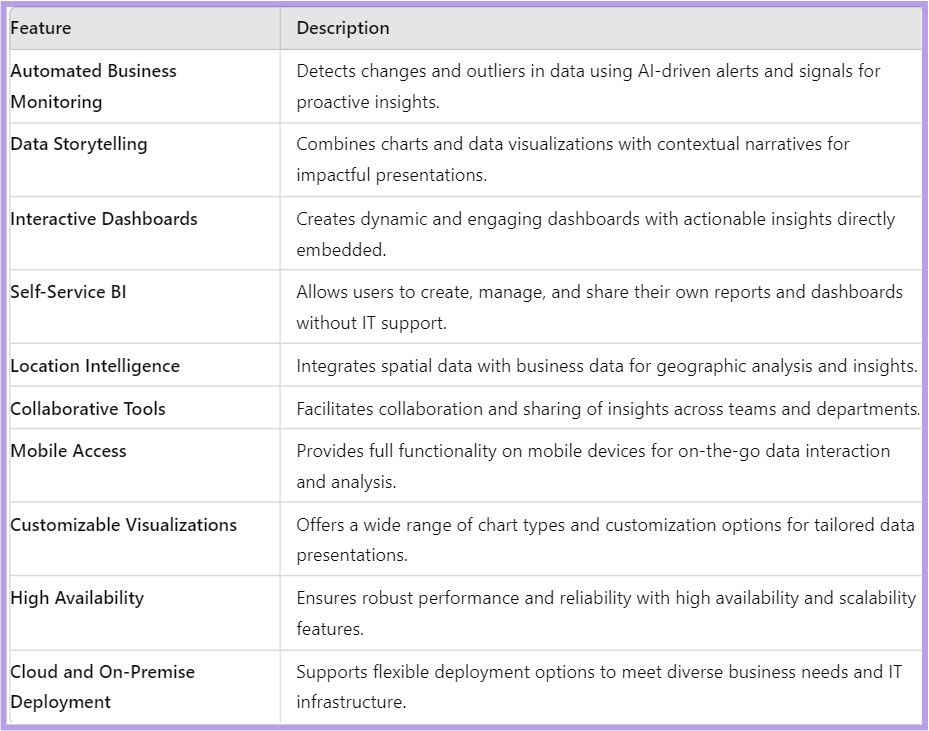
11. Domo
Domo transforms business by making data work for everyone, enabling impactful decisions through its cloud-native data experience platform. It goes beyond traditional BI by embedding analytics into applications and workflows, providing user-friendly dashboards and AI-driven insights. Domo’s platform integrates seamlessly with existing cloud and legacy systems, optimizing business processes and driving exponential results for over 2,000 global companies.
Key Features Highlighted by Reviewers
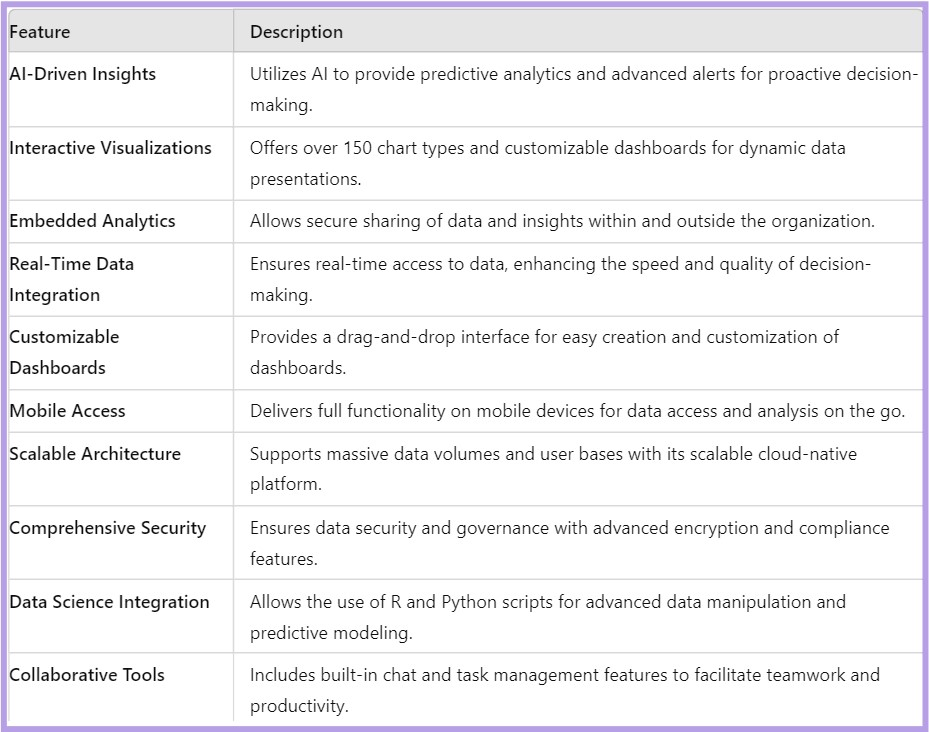
12. Zoho Analytics
Zoho Analytics is a self-service business intelligence and analytics platform that enables users to easily analyze business data and create insightful reports and dashboards for informed decision-making. It supports data integration from over 250 sources, allowing users to visualize data through an intuitive drag-and-drop interface. With AI-powered analytics and a cloud-native architecture, Zoho Analytics provides robust and scalable solutions for businesses of all sizes.
Key Features Highlighted by Reviewers
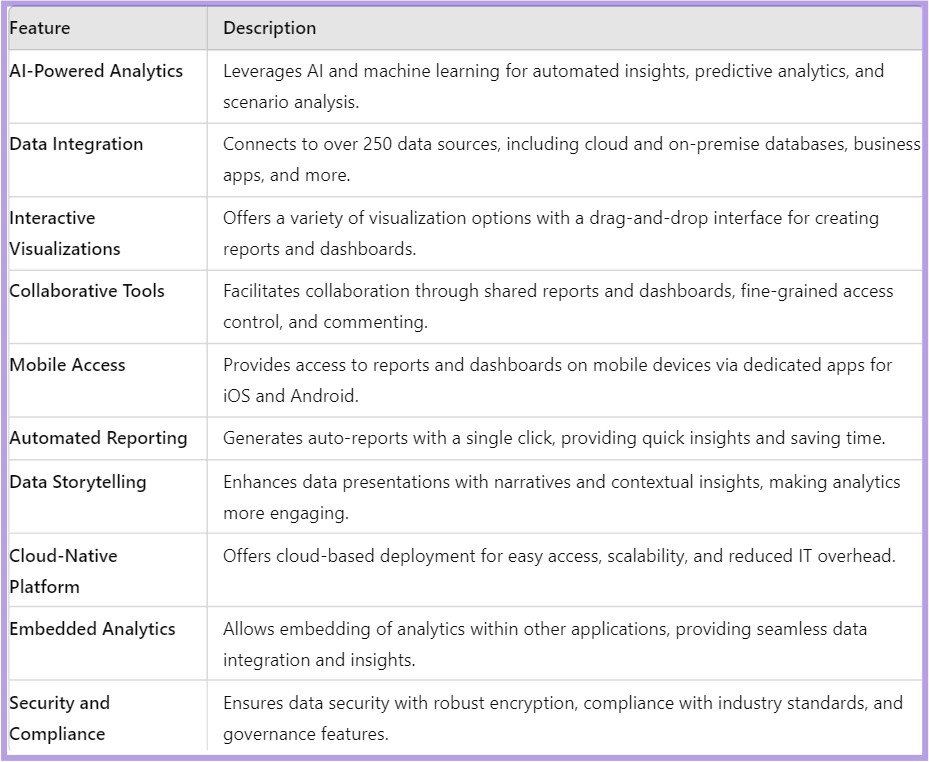
13. OWOX BI
OWOX BI is a comprehensive marketing analytics platform that simplifies data collection, preparation, and reporting for businesses across various industries. It enables seamless integration with Google BigQuery, automating the process of combining data from multiple sources like websites, CRMs, and advertising platforms. With features like server-side cookieless tracking and pre-built SQL transformation templates, OWOX BI helps businesses create detailed marketing reports, identify trends, and optimize their advertising spend efficiently.
Key Features Highlighted by Reviewers
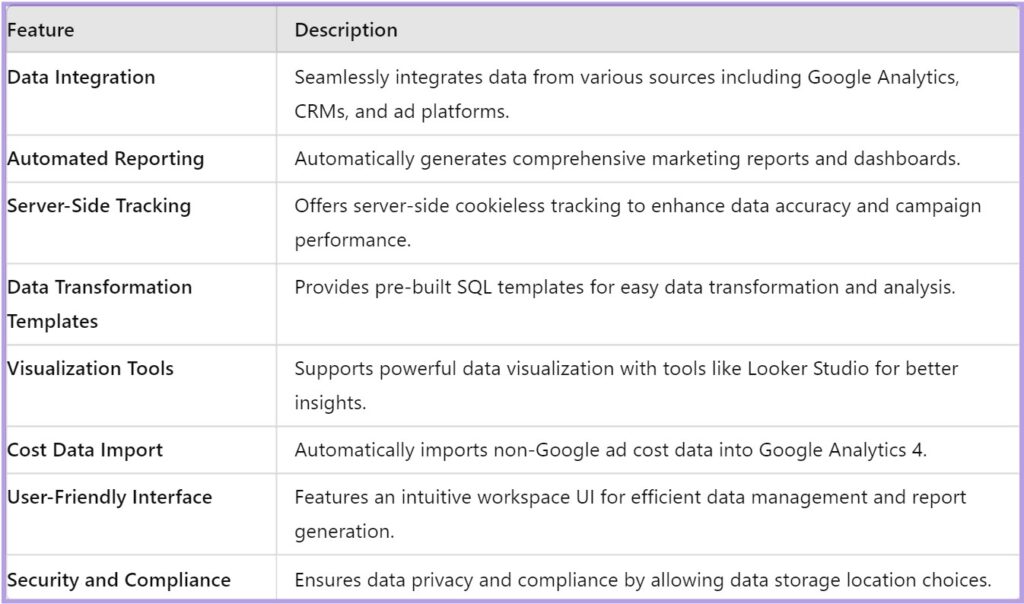
14. Insight BI
Insight BI allows businesses to combine data from various sources into colorful dashboards and reports, enhancing data visualization and decision-making. Reports can be scheduled for distribution, eliminating the need for manual report generation. This tool streamlines the reporting process and ensures that stakeholders receive up-to-date insights without logging in.
Key Features Highlighted by Reviewers
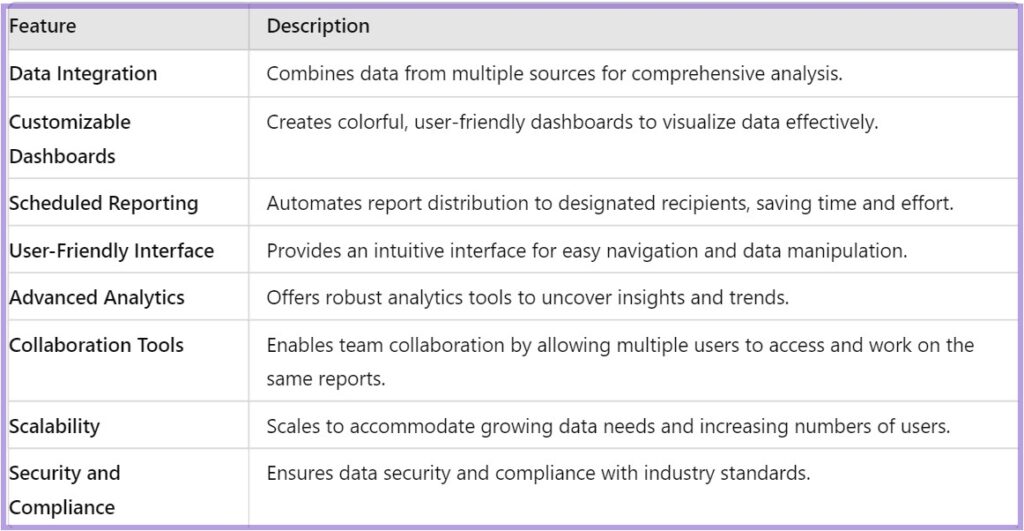
15. MyDash
MyDash is a dashboarding business intelligence platform that helps top organizations make faster decisions by making critical data more accessible. It offers free dashboards, connectors, and visualization libraries, focusing on cost-effective solutions for business intelligence needs.
Key Features Highlighted by Reviewers
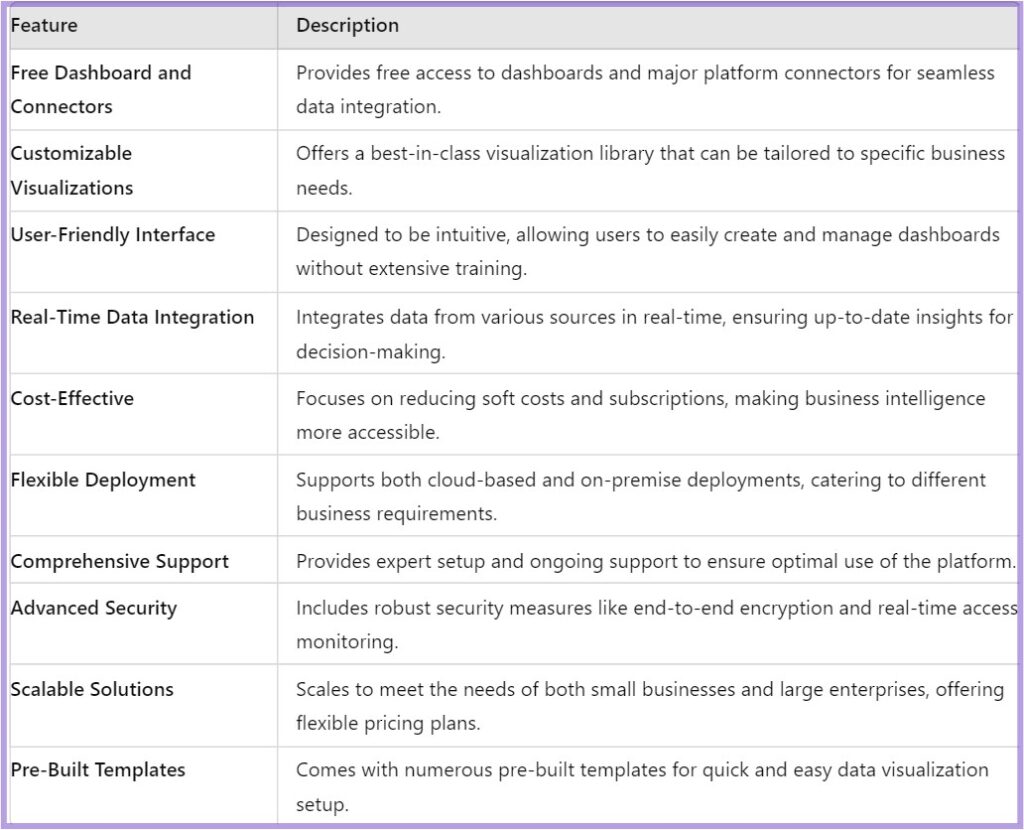
The Path Forward for BI
The landscape of data management is evolving, and with it, the role of Business Intelligence. Emerging trends such as data marketplaces, active metadata management, and data mesh architectures are reshaping data governance practices. These developments emphasize a more decentralized approach to data management, allowing for greater flexibility and agility.
As the demand for real-time insights continues to grow, BI tools are expected to become more integrated with operational systems, providing up-to-date information that supports decision-making processes. The future of BI will likely see a shift toward more automated and intelligent systems that can provide actionable insights with minimal human intervention. Moreover, the focus on cost-effective BI solutions will drive innovation, making advanced analytics accessible to smaller businesses and startups. Efficient cloud cost management and the availability of open-source BI tools will open opportunities for new players in the market. As we move further into 2024 and beyond, the transformation of BI tools will continue to accelerate. Another significant development is the increased focus on user experience within BI tools. As organizations strive to democratize data access, ensuring that BI tools are intuitive and user-friendly becomes paramount. Finally, the adoption of edge computing is set to enhance the capabilities of BI tools further. By processing data closer to the source, edge computing reduces latency and enables faster insights. This is particularly beneficial for IoT applications, where vast amounts of data are generated at the edge. By leveraging modern BI tools, organizations can transform their data into actionable insights, making informed decisions that propel them towards success.





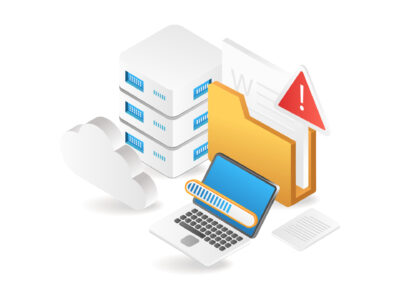
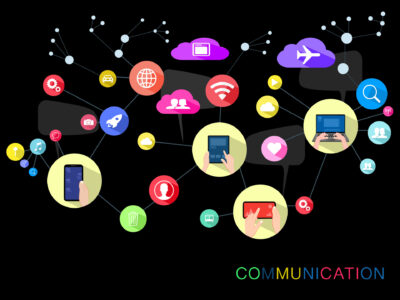












I found the detailed exploration of Business Intelligence software in this article both informative and engaging. Well researched!
Impressive analysis of the top BI tools available today. This was a good resource since I was actually finding the best tool as an advisory. Thanks Namrata.